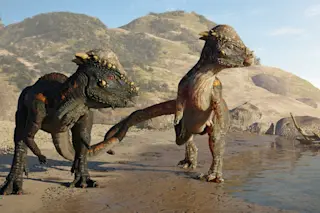Partway down the list of household dinosaur names, you may know the pachycephalosaurus.
Even if you don’t recognize that formality, the dome-shaped head of this creature is notorious, much thanks to its combative force in the Jurassic Park franchise. But plenty of aspects of this dinosaur remain elusive to experts.
Pachycephalosaurus Facts
The pachycephalosaurus is the largest in a group of bone-headed dinosaurs, pachycephalosaurids, made up of around 20 species, says Aaron Dyer, a paleontologist at the University of Toronto.
Pachycephalosaurus Size
They vary in size from larger specimens — weighing around 800 pounds as adults — to as small as 65 pounds. Known from North America and East Asia, these dinosaurs roamed the Late Cretaceous period, roughly 76 to 65 million years ago, alongside other famed species such as the club-tailed ankylosaurus and the notorious Tyrannosaurus.
Pachycephalosaurus Diet
Though commonly listed as a herbivore, the discovery of a remarkably well-preserved pachycephalosaurus skull indicates that it may have consumed meat with velociraptor-like teeth.
Read More: Is the T. Rex Three Different Species?
Pachycephalosaurus Shape and Mobility
They were also bipedal and “stocky animals”, says Dyer.
“These were not animals that were built for running long distances or bursting out in fast speeds,” he says.
It’s also thought their long tails may have acted as a third leg, allowing them to prop themselves up.
“That’s something quite unique to Pachycephalosaurs,” Dyer says.
Head Butting Dino
Pachycephalosaurus — which means thick-headed lizard — is of course known for the distinctive dome on its head. These skull caps were accompanied by small horn-like nubs.
A Dinosaur With a Hard Head
One of the most common theories behind this evolutionary quirk is their use in combat between individuals of the same species, Dyer says. But this has long been debated amongst paleontologists.
“The most telling evidence for me does come from the instances of disease and injury that we see on a good number of these domes,” he says.
Pachycephalosaurus Skull Injuries
Dyer also points to a 2013 study that showed around one-fifth of surveyed domes contained lesions on the skull.
“These injuries are consistent with types of infections that might be induced by trauma or blunt trauma to the top of the skull,” he says.
An alternative theory is that the dome acted as a kind of display for these creatures, indicating that an animal “is in its prime, it’s healthy, and it’s good to go for breeding,” Dyer adds, though these two explanations are not mutually exclusive.
Lack of Full Pachycephalosaurus Skeletons
While a host of dome fossils are known to paleontologists, few elaborate skeletons of this species have been found, which creates some substantial knowledge gaps.
For instance, how the species evolved its dome feature remains unclear.
“The oldest pachycephalosaurs in terms of the geological record already have fully developed domes,” Dyer says.
It’s thought that juveniles were flat-headed and that the dome grew with age. And transitional forms are so far missing from the fossil record.
Read More: Here’s What Dinosaurs Really Looked Like
Revising How Dinosaurs Really Looked
Scientists have continually been expanding and revising our understanding of what dinosaurs truly looked like.
Fossil findings and new technologies are adding color, feathers and other features to species. What this means for the pachycephalosaurs, however, remains to be seen.
“We have no idea what coloration those domes might have had,” Dyer says. “I suspect that they probably were brightly colored to some extent.”
Whether the dome was used for combat, display, or perhaps both, indicates that they possibly lived in large groups similar to modern ungulate species.
Seeking More Pachycephalosaurus Fossils
To date, paleontologists have identified a lack of pachycephalosaur “bone beds” — or mass death sites of large groups of dinosaurs — and fossil trackways left behind by migrating herds.
Finding either of those, especially with older fossils, would likely answer some of the lingering questions about this unique species.
“Once we start finding those primitive pachycephalosaurs that are 20, 30 or 40 million years older than the ones we currently know of, that's when we can really introduce an evolutionary stepping-stone kind of analysis,” Dyer says.
Read More: Why One Extraordinary Collection of Dinosaur Embryos Remains Locked Away From Science















